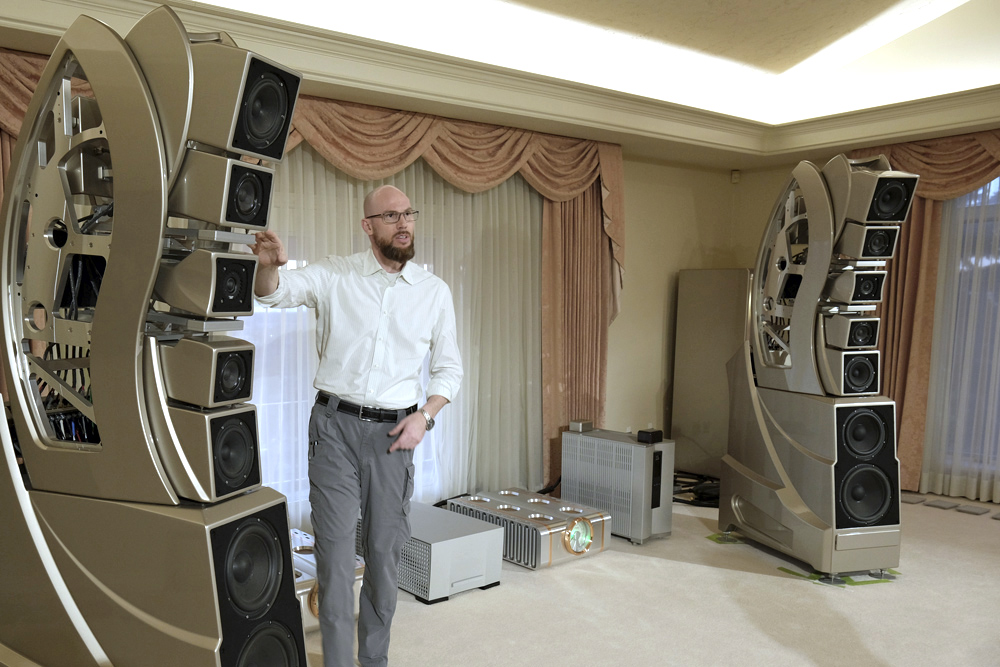There’s a distinct feeling, a saturating melancholy as we drive the open road through the American West. It’s the vistas of barren desert and red-earthed canyons. The romantic depictions in Hollywood-SuperScope and panoramic art inspired by the folklore of pioneering wagon train settlers, fortune-seeking adventurers and fierce pony-riding warriors. It’s with that mood-blanket that I launch into the road trip – to Salt Lake City and on to Provo – across cracked desert hard-bordering snow-crowned mountains. In Provo, at the foot of the soaring Rockies, we arrive at Mountain Vista Lane, Wilson Audio HQ.
Creative People
This is in fact my second visit to Wilson Audio. Back in 2011, post CES that year, I travelled across from Nevada to Utah to meet David Wilson and tour the just-expanded new facility. I was fortunate to spend many hours – spread across two days – with David Wilson, a true gentleman and, of course, now a genuine industry icon. The carefully curated selection of music David spun for me, via both analogue and CD, demonstrated the excellence of the majestic X2 Series 2 (my visit was about a year prior to the launch of the XLF) and gave me an insight into David’s wide-ranging music palette.
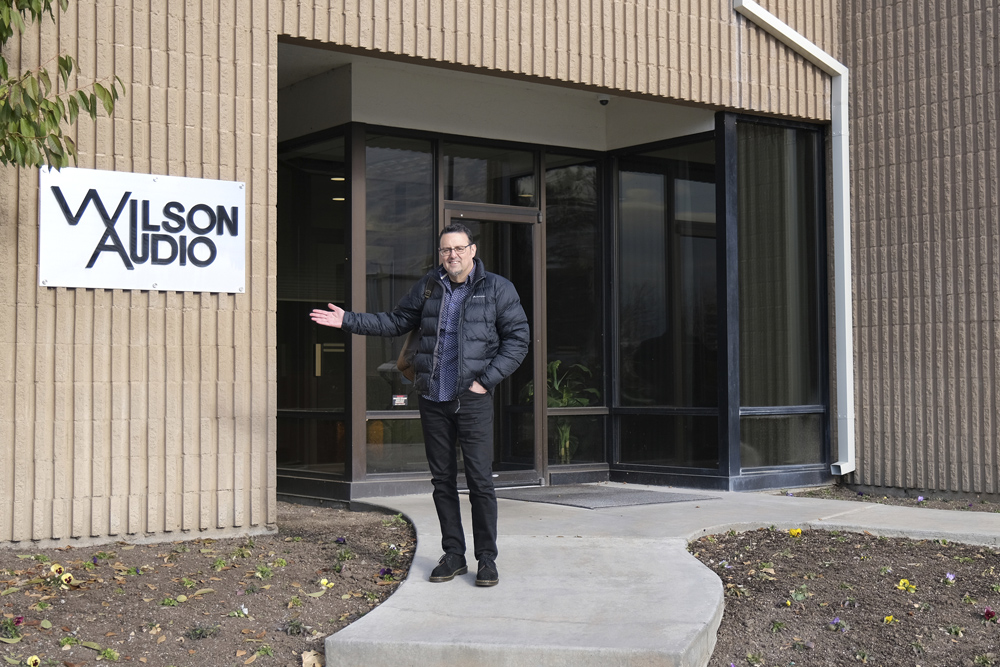
Today, along with travelling companion, and Wilson Audio distributor, Nigel Ng from Advance Audio Australia, we’re ushered into the company boardroom as an acclimatisation basecamp. We exchange greetings and catchup chit chats with Director of Sales Trent Workman, Marketing Manager Tyler Hall and newly appointed Account Executive David Ellington.
Now, Daryl Wilson enters the boardroom. He’s warm, open-armed… a welcoming presence. Then, within minutes, he plans-out and scripts our entire day onto a whiteboard. Schedule’s looking good…
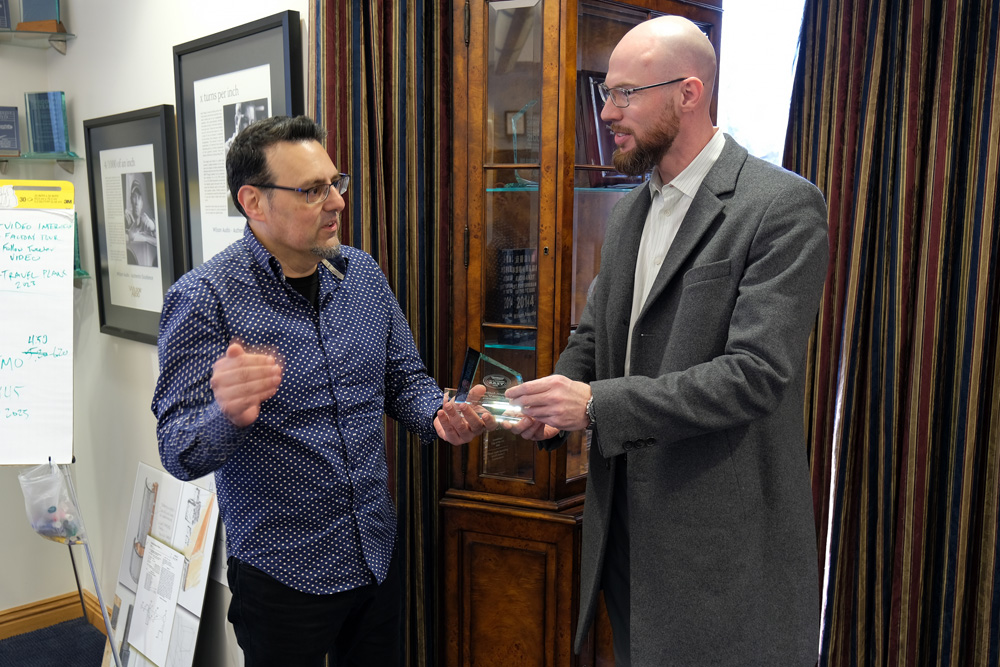 Presenting CEO Daryl Wilson the Alexia V SoundStage! Australia 2022 Award for Outstanding Performance.
Presenting CEO Daryl Wilson the Alexia V SoundStage! Australia 2022 Award for Outstanding Performance.
There’s been significant growth since 2011, quite naturally for a company with Wilson Audio’s industry reach. Aside from the expansion in terms of escalating manufacturing volume as a result of stronger market share (and the associated parts inventory, warehousing requirements, etc.), Wilson Audio has also had to accommodate its acquisition of capacitor specialist Reliable Capacitors. This meant Tetris-fitting a host of capacitor winding machines and additional specialist personnel. Housing the new department subsequently required the construction of a dedicated annexed area.
Guided by an increasingly vibrant Daryl Wilson (his enthusiasm for his company and the industry at large is evident), along with stand-by support from all three gents in the boardroom, we start the tour – first, across a corridor highlighted by a framed near-full-wall photo collage vivid with near-on 60 employee portraits. The proud display is not just showcasing “Names on a board” as Wilson qualifies, it’s actually symbolic of one of the company’s strongest philosophical principles: The people are the heart and the soul of Wilson Audio.
With that fundamental axiom in mind, we move on to one of the most important aspects of Wilson Audio loudspeaker designs. Quite aside from other evolved engineering factors in its products, the proprietary materials used in Wilson Audio speaker cabinets have become a trademark aspect of the company’s designs.
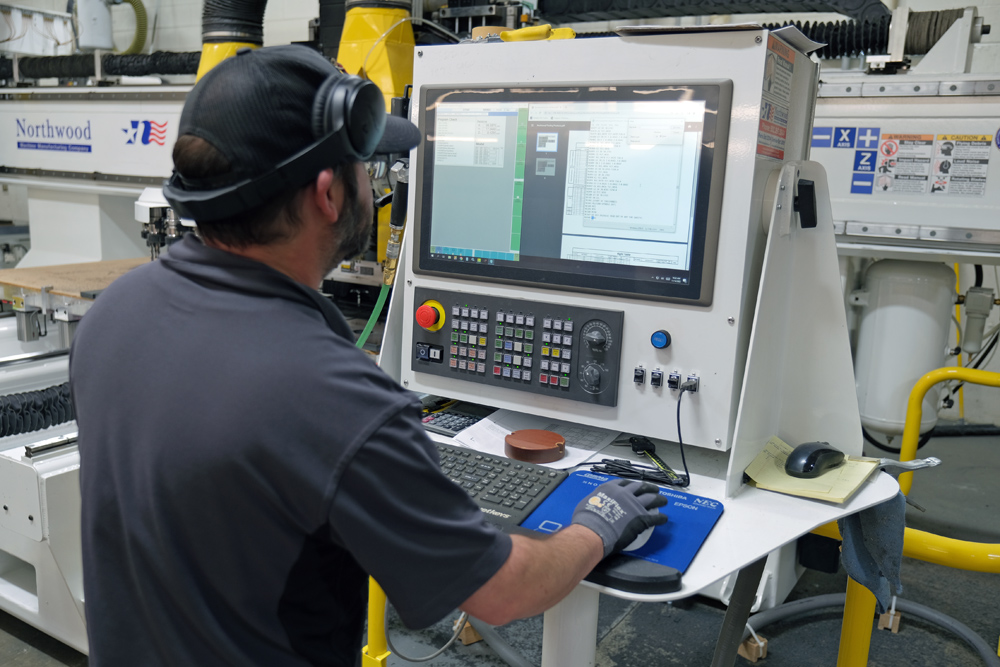 Jamie programming for CNC cabinet panel machining.
Jamie programming for CNC cabinet panel machining.
We enter the ‘Fab Shop’ a fabrication area where raw cabinet materials are precision CNC-machined (by Jamie at the time of our visit) into the various panels prior to being assembled into a given cabinet. The hard materials used in Wilson Audio cabinets are very demanding of tooling bits and cutters. Cutting bits would normally last hundreds of cycles if machining commonly used MDF, for example. Here, the lifespan of these expensive CNC machine parts is but a fraction. The two-heads/two-tables CNC machine setup (active and stand-by arrangement) precisely cuts the angles and curves of the various enclosure panels. It also shapes the internal panel surfaces in pre-determined patterns fashioned to minimise reflections and structural distortions.
The many and various panels, machined from X-, S- and V-Materials – each panel costing hundreds of dollars – are then fastened together with a special adhesive formulation designed to provide high strength while also being resistant to moisture, panel flex, etc. Here, we begin to understand the massive costs involved in producing even the raw cabinets of a Wilson Audio loudspeaker.
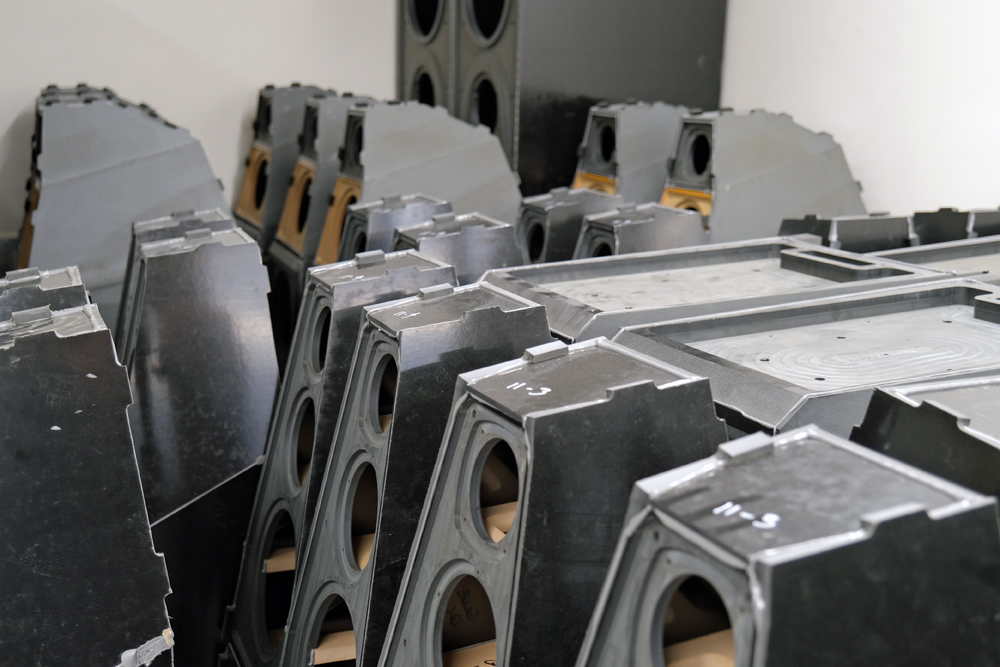 Glued cabinets in readiness for the first of many polishing stages.
Glued cabinets in readiness for the first of many polishing stages.
At this stage the speaker is documented and given a ‘birth certificate’. Of note, each craftsperson who has worked on the cabinet signs his/her name on the cabinet interior. As Wilson says, “it’s not just Wilson Audio on the name tag on the back of a speaker. It’s every person’s DNA…”
Onwards. The glued cabinets are then moved to an ancillary ‘Pre-Prep’ area where both machine-sanding and hand-shaping further refine the cabinet architecture. Additional close inspections then clear the cabinets to be moved to the paint preparation stages. Here’s where things become super-high tolerance.
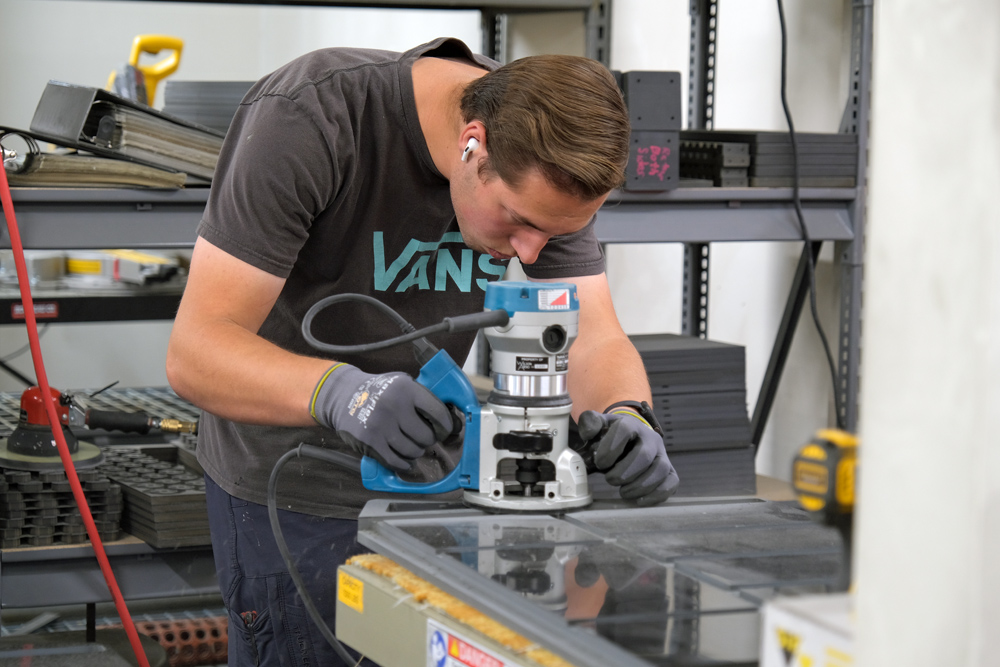
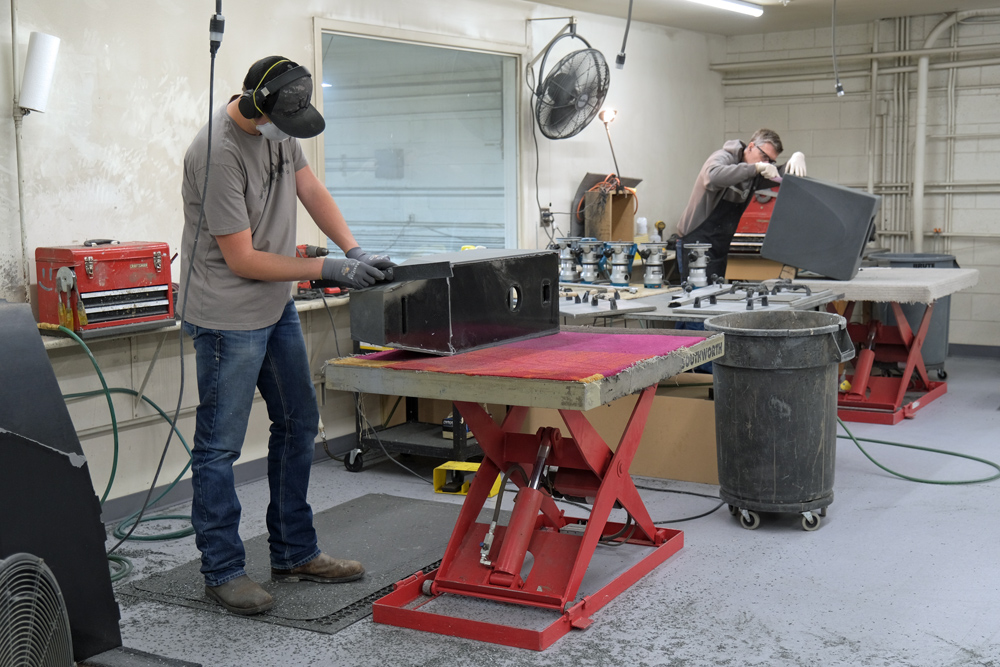
“People want a mirror-like paint finish. To do that you have to think about the very first step and every step in-between in the paint process,” affirms Wilson. He goes on to explain the extreme tolerances involved in the handling of the cabinet surfaces in preparation for the crucial spraying stages. “The feeler gauge, which is a thin piece of metal which is used to spot imperfections is four-thousandth of an inch. That’s how flat it has to be before it goes to get gel-ed [the next phase of production]”, Wilson explains.
That segues to the spray-application of gelcoat, a special paintable skin which is applied to the entire cabinet in order to achieve the best result when colour sprayed. Gel preppers further sand down the skin to half the tolerance of the previous stage – so down to eight-thousandth of an inch. It’s a multi-stage process with several go-overs with sanding, inspecting, re-sanding, re-inspecting, etc.
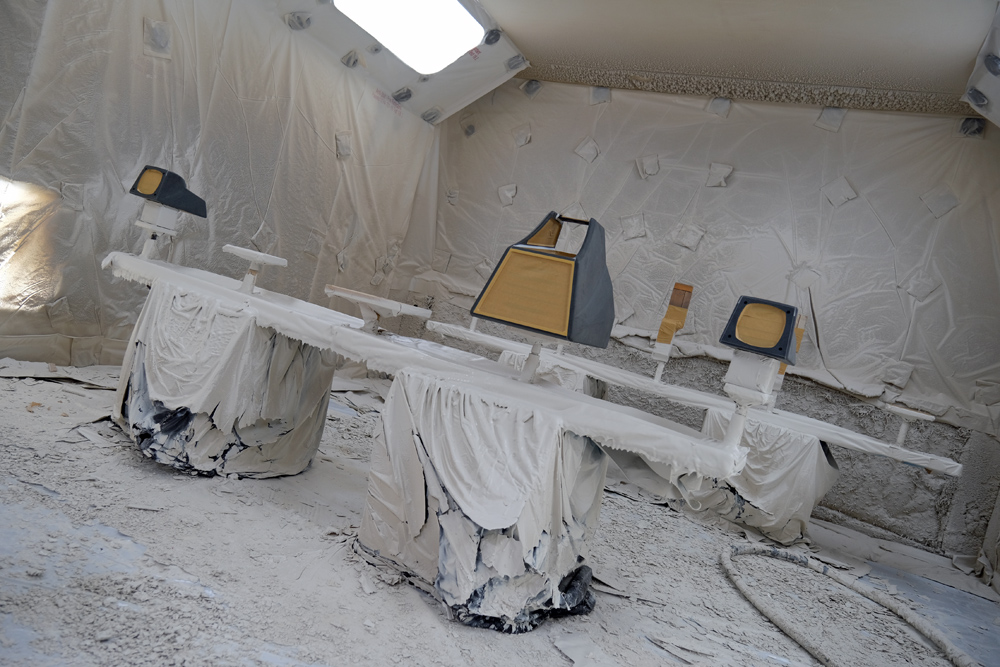 The gel-coat spraying booth.
The gel-coat spraying booth.
As Wilson puts it, “The craftspeople here are thinking about the tolerances they have to keep because they know down the line, those other craftspeople rely on their skills. There’s a certain amount of pride in knowing they’ve done their job well and there’s faith and trust in the next person to do their job well.” Related to that statement is the last step in this department, the QC stage prior to moving further down the process line, “Perfection is unattainable, excellence is well within our reach”.
An invaluable resource, when it comes to the finish of Wilson Audio speakers, is the paint spray department. Here, several booths provide a dust-free environment for the experienced painters. Multiple layers of Clearcoat are applied and refined over what is, overall, a quite extensive and labour-intensive process carried across several cabinets per booth.

An area just to the side is dedicated to the curing process. Wilson tells me “A standard finish takes a minimum of four to five days to cure. For some pearl finishes, it’s weeks before we can polish. Cranberry Pearl takes about two months. We’re told ‘why don’t you just ship product sooner instead of having it sit there’, I say no… we’re willing to be patient and allow the product to naturally cure, we do what’s necessary to get an end result the customer expects.”
As we progress through, a variety of components, such as Alexia V tweeter pods and Alexx V’s ‘gantry’ skeletal framework, are in-between processes. They’ve been cured, or are very nearly cured, and now await the polishing stage. Once again, this is a multi-step process of inspection, super-fine grit sanding (800, 1200 and 1500 grit stages) and careful polishing, then re-doing the process as many times as it takes to achieve the renowned mirror-like finish of Wilson Audio speakers.
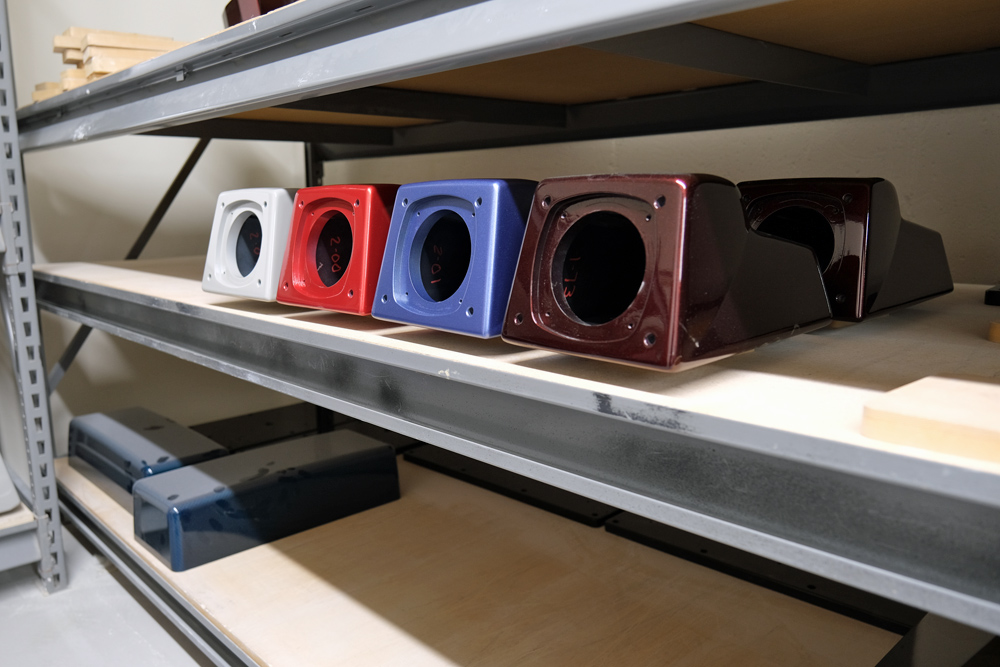
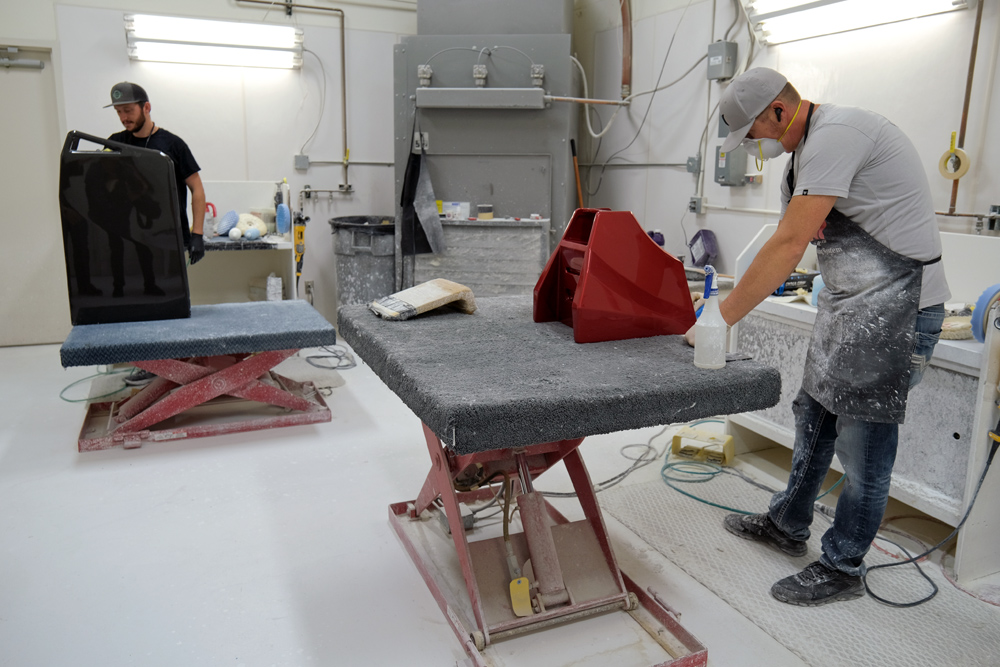
After all that, however, the paint department’s QC gives each speaker a final once-over where the smallest imperfection is documented. The flawed speaker is then quarantined and barred from progressing along the fabrication line. The imperfect unit is repaired or even taken to the start of the process for repainting. Finally, a manually-applied ‘frisk’ – a thick plastic film – wraps the entire cabinet in order to protect the paint finish through the final driver/crossover/wiring assembly stages, boxing, freighting and, finally, installation at retailers’ showrooms and end-users’ homes. That’s the end of the paint process.

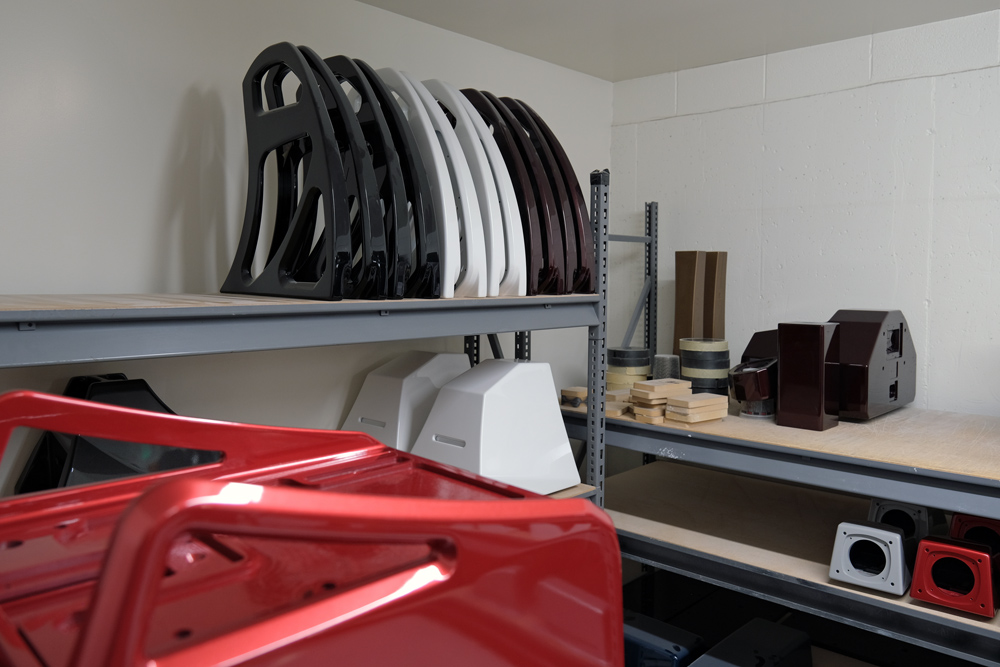
Capacity for Capacitors
We enter a self-contained ‘Production’ area where several technicians are handling cable looms. Joe was crimping cables prior to passing them on to Nick who handles the soldering to end lugs and spades which are Wilson Audio-designed though externally supplied. Each cable type, the various gauges and the specific number of wire twists, are dedicated to a specialised role within the design of a given speaker. In other words, the cable type (and length) that connects the tweeter to the crossover, or the crossover to the bass drivers, is dedicated to that task and that speaker model in consideration of ultimate sound performance.
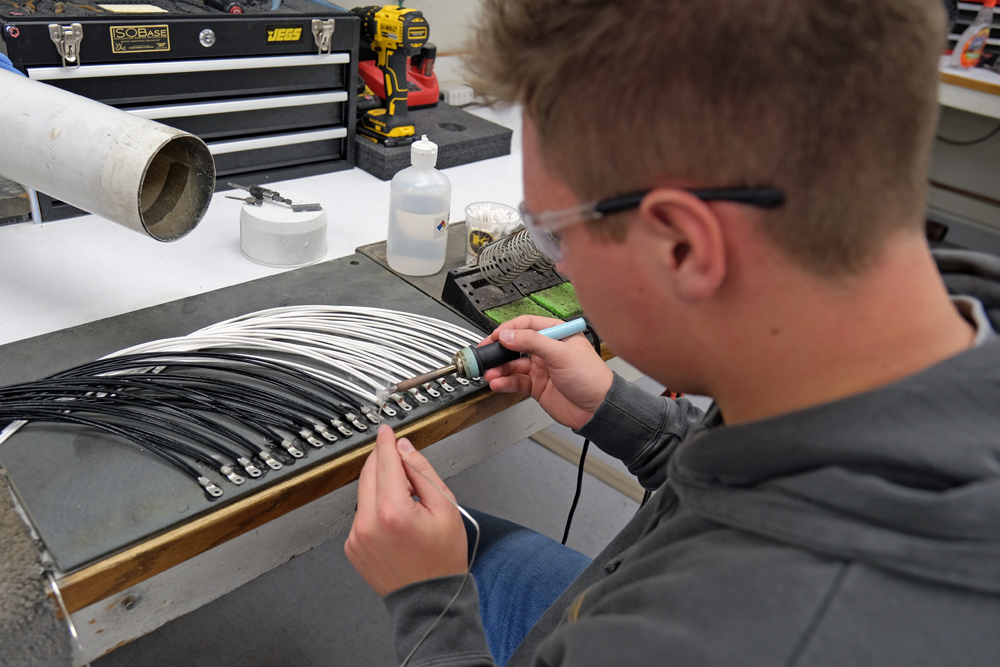
The Wilson Audio crossovers are point-to-point-soldered exact replicas of the super-tweaked version developed in R&D. Once fabricated, the crossovers are then potted in a special epoxy within a sealed dedicated enclosure as per Wilson Audio tradition. Due to the temperature the epoxy reaches, the crossovers are then tested once again – three measuring tests in total.
Wilson proudly states, “… our crossovers are beautifully made point-to-point and neatly laid out even though they are potted and will never be seen. A quote from Michelangelo, which I absolutely love and goes to the heart of excellence in all things, is where he’s painting the Sistine Chapel and he’s working on a small, far corner of the ceiling. Someone asks ‘why are you painting up there, no one’s ever going to see that?’ Michelangelo replies, I see it and God sees it.” He explains that’s a culture which all the craftspeople at Wilson Audio adhere to at every level of production.
So the crossovers now feature the new AudioCapX-WA which are exclusive designs for Wilson Audio products. The capacitors are wound in-house on legacy devices, however, Wilson Audio has invested in two new Swiss-made machines (due to arrive in January 2023) to be designated a recently-built area purely to the production of the capacitor products. According to Wilson, the current production capacitors have been redesigned to achieve superior performance and overall build quality. “I never thought I’d get excited about capacitors” Wilson says with a chuckle.
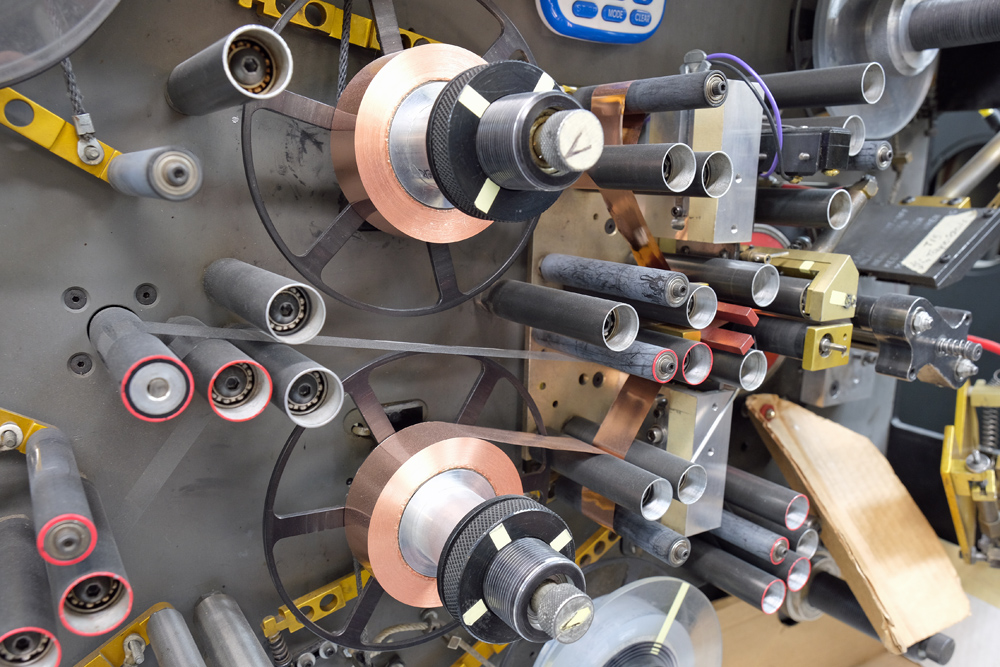 The guts of a legacy capacitor winding machine.
The guts of a legacy capacitor winding machine.
Our next stop lands us into an area where dozens of drivers are in the process of being tested and factory-burned-in. “We work hand-in-hand with our driver suppliers. We receive multiple samples, we burn them in, listen to them and evaluate them. We look at the design and then we think, how can we get these to sound closer to what we need in the application it’s being utilised in”, clarifies Wilson, going on to say, “Then we go back and forth, make changes in response, or specific areas, what can we do with the spider, the magnet structure… we evaluate every aspect of it. Then we evaluate the modifications and go back and forth for, sometimes, over a year. Then we get the driver that we like but also know we can do things in-house too beyond what we get from our vendors. We further modify them before we install them for all our models. That applied of course to the new QuadraMag driver.”
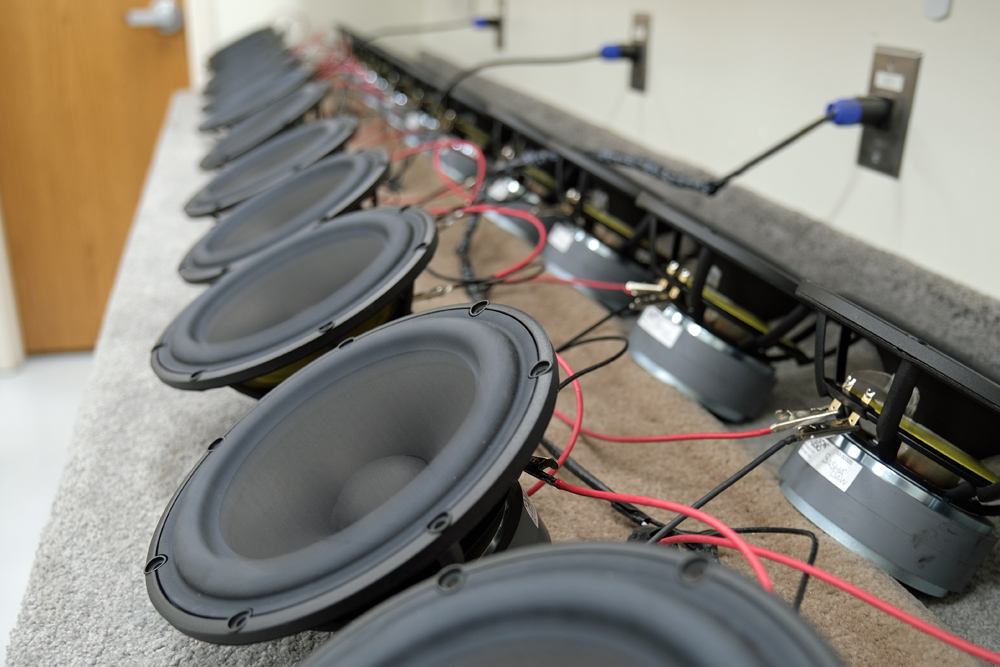
Acoustic and electrical measurements take place just beyond this area. Wilson explains how, while some models are yet to be updated with the current driver technology, in the case of the WAMM Master Chronosonic for example, the sum of its parts makes for a synergistic relationship of parts which defies and goes well beyond merely replacing older drivers for newer ones. It’s an overall creation which David Wilson meticulously micro-interrelated every component and function to achieve the excellence of the holistic concept.
In a nook around the corner Clint specialises in handcrafting loudspeaker grilles. He has been refining the manual process over years. A Wilson Audio grille is not only acoustically transparent, as far as the applied textile permits, its framework is constructed from proprietary material while being made to fit onto the speaker with tight precision in order to avoid vibrational distortions. “Many customers uncrate the speakers and place the grilles right back in the box. That doesn’t deter Clint from doing his best.” Once again, that Michelangelo ethos…
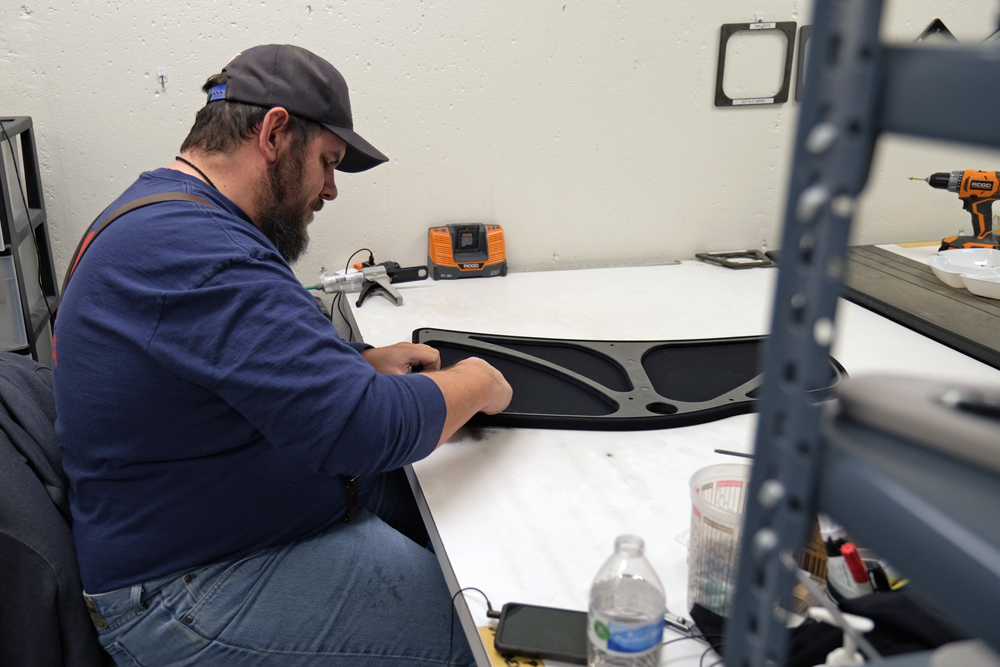 Clint building speaker grilles.
Clint building speaker grilles.
An open showroom along the way sees a proud parade of past products on proud display. “Right back from the SMART turntable to the current WAMM, Wilson Audio has produced 70 products.” Our product showcase journey takes us to the WATT serial number 1 and its inspirations in the CUB, Duette and TuneTot, through to an oak-panelled WATT/Puppy through the iterations leading to Sasha.
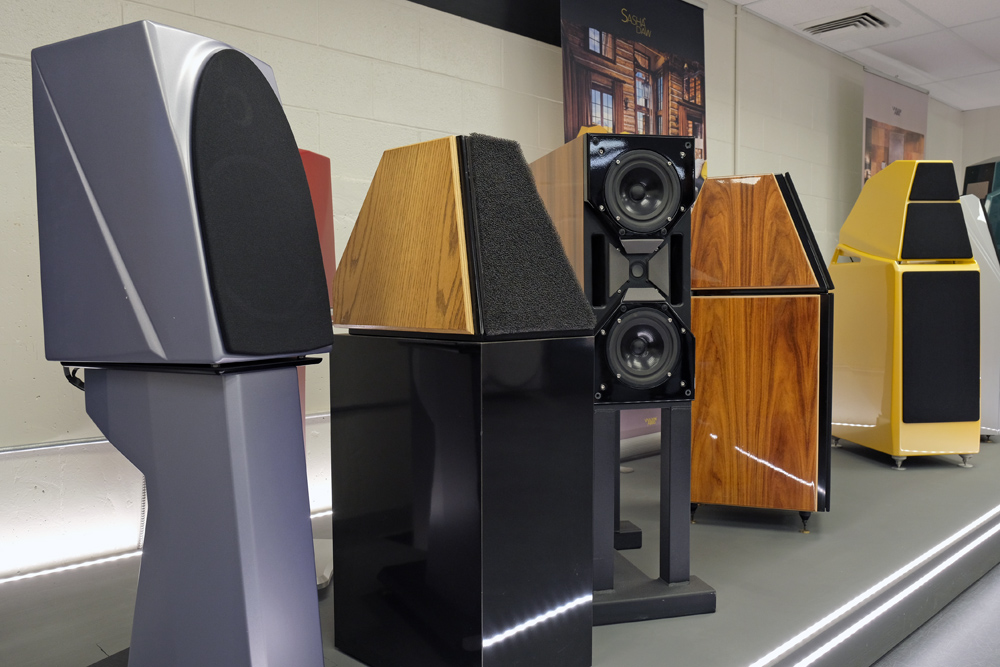
An additional vignette featured non-adjustable, fixed baffle designs which included the relatively short-lived WITT through to Sophia, Yvette and the smaller Sabrina. The closing chapter of the overall display sees the original WAMM through the MAXX and past other large floorstanders like the iconic X-1 Grand SLAMM, Alexx and finally the current flagship Chronosonic XVX. In between we were shown massive subwoofers such as the WHOW (Wilson High Output Woofer) the XS, Thor’s Hammer and Watchdog. Quite a remarkable history.
In fact later, in an archival area where documentation on every speaker produced is stored, Wilson shows me a small booklet. In it are free-hand and formal architectural drawings, tests, measurements and hand-written notes by David Wilson. A glimpse at the booklet’s cover showed it to be for WATT serial 1.
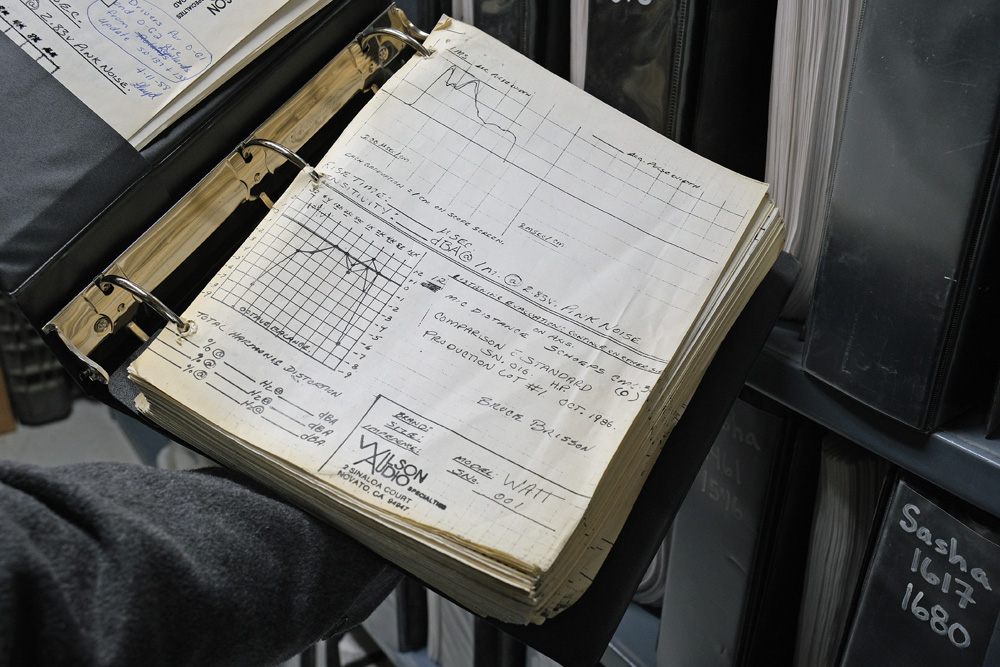
Finally, we inspect several development and product demonstration rooms used for auditioning in real-world scenarios and for staff and dealer training. Here, the acoustics are good but not studio-level-perfect, serving as a representation of real-world living environments. A variety of high quality electronics are employed to support the speakers being demonstrated.
Time Stood Still
The visit culminates with a special treat. A meeting with Sheryl Lee Wilson (company Vice President) and a listening session in the famous ‘pink’ room at the Wilson home. While the last time I was there David Wilson showcased the X-2 in an unforgettable evening of great conversation and extraordinary music playback, this time, I was to sample David Wilson’s Magnum Opus – the colossal WAMM Master Chronosonic. The WAMM MC masterwork project took five years to develop and encompassed David Wilson’s full creativity and design expertise.
Prior to the listening session, Sheryl Lee Wilson shares insights into the early days of Wilson Audio. Sheryl Lee and David shared a deep love of music and began the Wilson Audio endeavour to express it. The desire to articulate their mutual passion for music led to far afield adventures to record live performances. These recording exercises were the catalyst for the launch of the Wilson Audiophile Recordings label and its famous catalogue of jazz and classical music. As Sheryl Lee reiterates, the juxtaposition between the on-site experiences and the recordings abetted by David Wilson’s WATT field monitor and his personal original WAMM reference back at home, guided a sonic path. It was to become the signature ‘Wilson’ sound which is since instilled in every product – resoundingly dynamic, decidedly precise, assuredly high-powered and vastly generous in terms of soundfield reproduction.
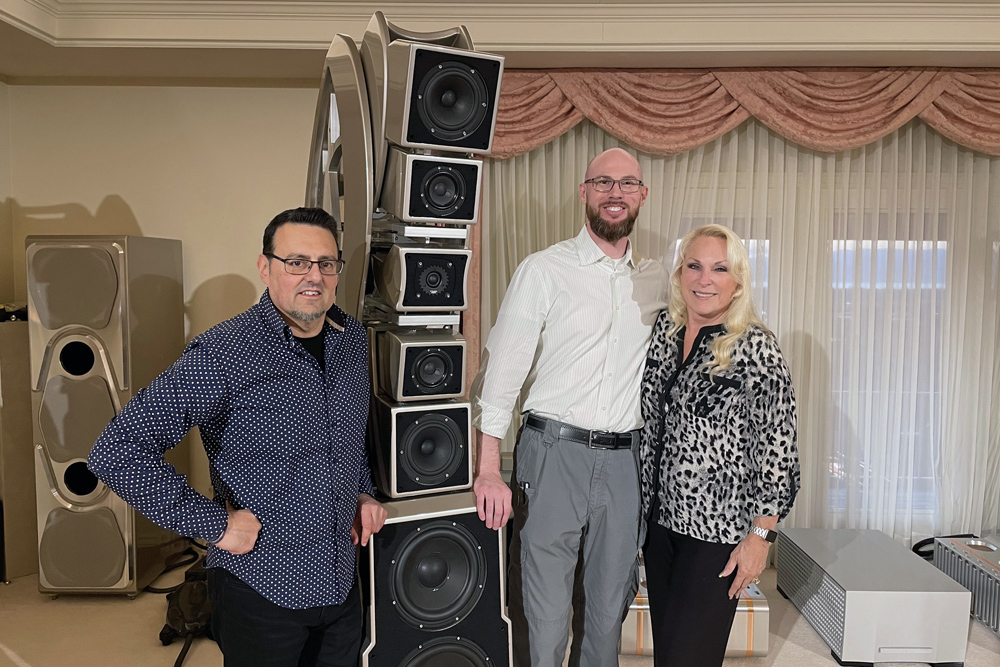 With Daryl Wilson and Sheryl Lee Wilson
With Daryl Wilson and Sheryl Lee Wilson
Back to the Wilson home in Provo 2022. Because the WAMM demonstration room is also a living space, it eschews acoustic panels treatment. Having said that, the acoustic signature of the environment has been given extraordinary levels of attention resulting in a room that virtually disappears, allowing a system’s full potential to bloom.
Supporting the WAMM MC is a stellar assembly of high-end audio excellence. Of note, the considerable low-end power of WAMM MC is further supported by a duo of corner-positioned Master Subsonic subwoofers. Amplification is via Dan D’Agostino Master Audio Systems Relentless monoblocks (VTL Siegfried monos and Constellation Audio amplifiers are also available for comparison purposes), top-level VTL and Audio Research preamplification and dCS digital and Basis Audio analogue source componentry. Transparent cables are used throughout.
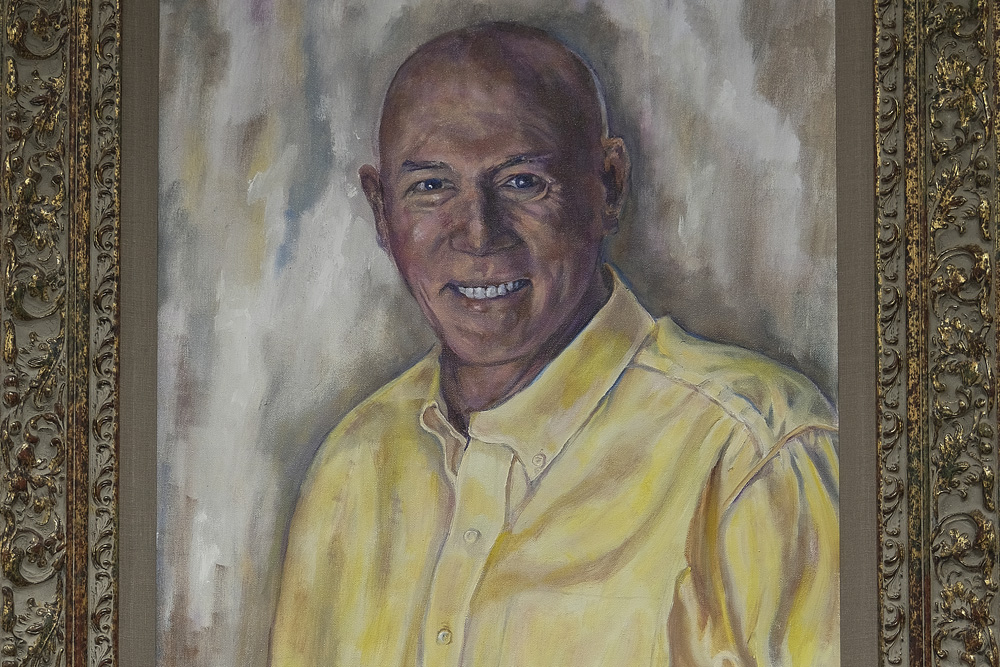 David Wilson
David Wilson
Daryl Wilson plays music from genres spanning classical, jazz, rock and even a powerful reggae piece – yes, Bob Marley had my skeletal framework vibing in unison.
Descriptors above aside, how do you start describing a sound which can be profoundly emotive while simultaneously being supremely faithful to the dynamics, detail and tonality of real voices and instruments. How do you disengage from joy in order to intellectually analyse precision? Yes, WAMM MC uncompromisingly provides the sonic stimulus for strict engagement.
It’s a stirring experience which imprints itself in my temporal lobe for permanence… Just like my encounter back in 2011 did.
Conclusion
As impressive as the Wilson Audio manufacturing facilities are in terms of the fundamental machinations of producing a world-class high-end loudspeaker, I leave with an even greater understanding of the company’s tenets, its culture, and the exceptional approach to all aspects of its undertakings. Of note, I was impressed by Daryl Wilson’s kind, nurturing and supportive demeanour towards his staff, at all levels.
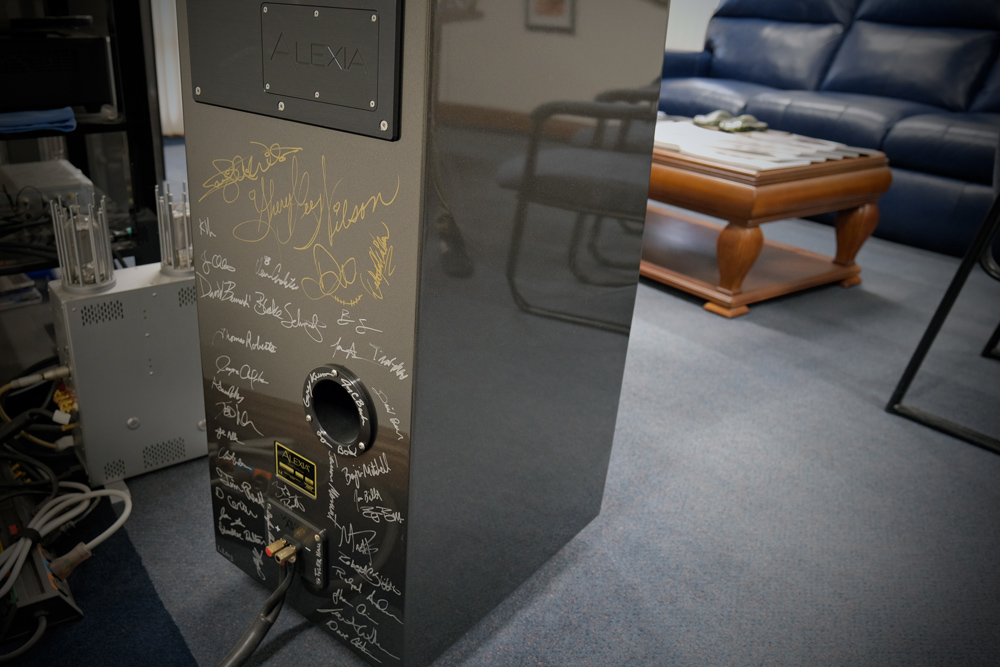
There’s a deliberate and clear pathway here. Whether it’s with the extraordinary levels of detail and meticulousness in every step of the loudspeaker manufacturing process, or whether it’s Daryl Wilson’s far-sighted ambition and his enabling the company’s and its workforce’s expression of creativity beyond his time. “It’s a 50-year plan”.
And finally, I gained a deeper sense of what a Wilson Audio loudspeaker ultimately symbolises – a common goal manifested by the systems, processes, efforts and personal craftsmanship at Mountain Vista Lane.
Yes, Daryl Wilson phrased it most succinctly, “… we could do things in a less expensive, simpler way, but we choose to do it in an ‘Authentically Excellent’ way…”
… Edgar Kramer
This email address is being protected from spambots. You need JavaScript enabled to view it.
Wilson Audio
Australian Distributor: Advance Audio Australia
+61 2 9561 0799
www.advanceaudio.com.au
Wilson Audio Specialties
2233 Mountain Vista Lane
Provo, Utah 84606
United States of America
1 801 377-2233
www.wilsonaudio.com






